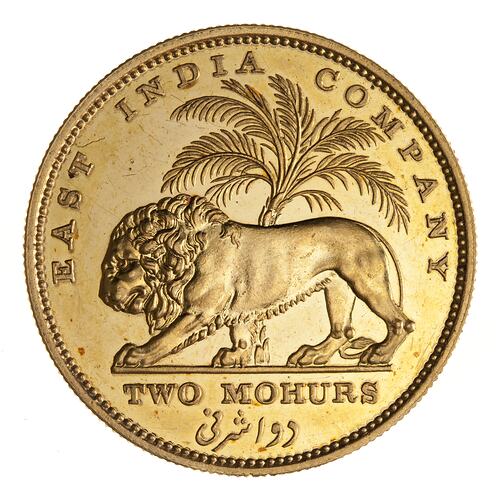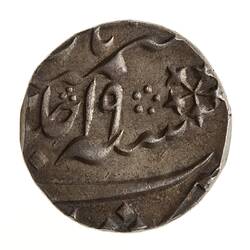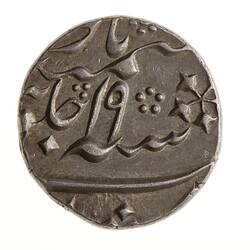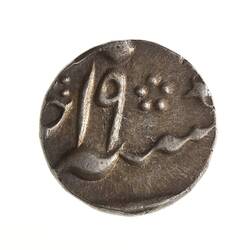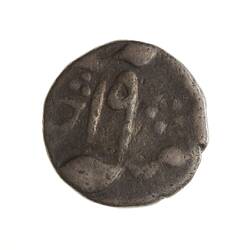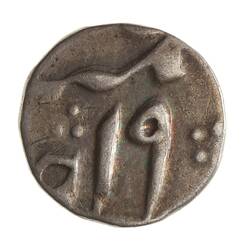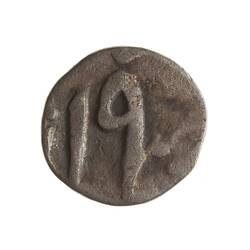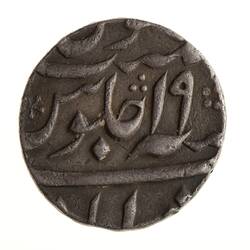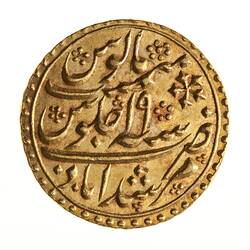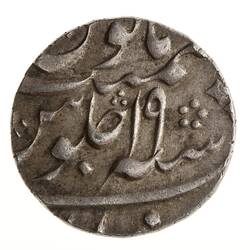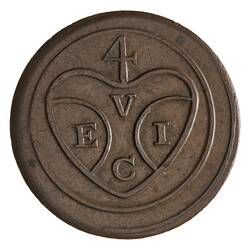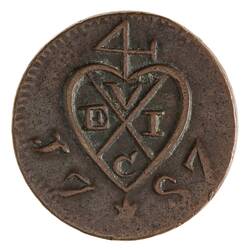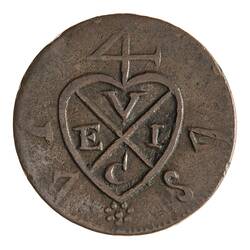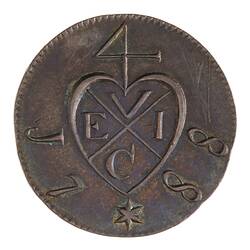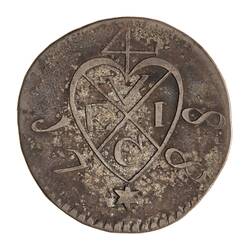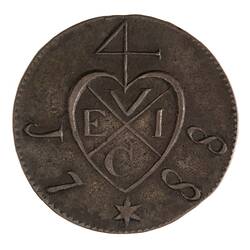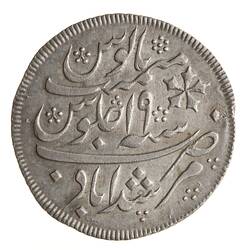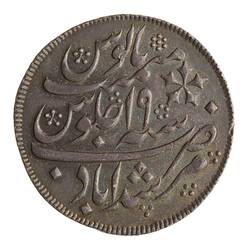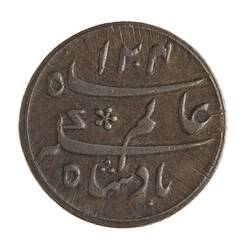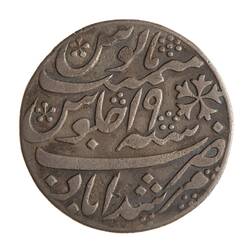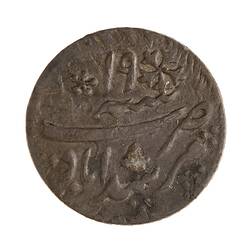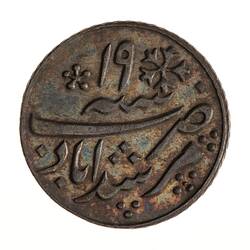Summary
The Calcutta Mint (India Government Mint, Kolkata) was established in 1757 by the East India Company under a treaty with the Nawab of Bengal. It initially struck gold and silver coins under the authority of the Nawab of Bengal. In the 1820s preparations for expanding the mint were begun, with the aim to increase capacity to 200,000 rupees a day. It was 1830 before the new mint began to strike coins. In 1860 a new set of mint buildings were established in the north of the Calcutta Mint grounds. Known as the Copper Mint it began operation in April 1865. The Calcutta Mint ceased operating in 1952 when a new mint was opened at Alipore.
When the East India Company arrived in Bengal it was governed by the Mughal Emperor from Delhi through an appointed financial minister charged with responsibility for collecting revenue, expenditure of public money and the administration of justice. In 1701 Murshid Kuli Khan was appointed to this position, at a time when the power of the Emperor had begun to decline. In 1704 he became Deputy Governor of Bengal, Bihar and Orissa and moved his capital to the town of Muxadavad which he proceeded to rename Murshidabad in honour of himself.
Although the Mughal Empire was breaking up, with Governors of its regions becoming independent rulers, the nominal authority of the reigning emperor was retained where it suited; coins for instance were struck in the name of the ruling Emperor and were dated according to his years of rule.
The East India Company settlement at Calcutta was established on 24 August 1690, its factory was fortified in 1696 and a major fort, named after King William III, was begun in 1700. In 1715 the Company's lands in Bengal were declared an independent Presidency of the Company and so responsible directly to London. The Company's rights to trade in the region were derived from the Emperor but increasingly depended on agreement with the Nawab (originally the Governor but by this date the local ruler) of Bengal. The East India Company had no right to its own mint, therefore to obtain current coin it had to send its silver and gold to the regional mint and pay the standard duties and mint charges. This situation had a number of faults as far as the East India Company were concerned, not the least of which was that there were often delays in obtaining needed coin.
In 1756 the Nawab of Bengal attacked and captured Calcutta and on 2 January 1757 Robert Clive took it back. Among the stipulations in the subsequent treaty between the East India Company and the Nawab was the right for the East India Company to have its own mint where gold and silver coins struck on the standard of the Murshidabad mint could be made (Pridmore, 1975, pp.185-186). These coins would be permitted to circulate in the region without additional charges.
The Nawab was not pleased. Although the mint began production, it was not until after his defeat and replacement at the Battle of Plassey that a formal documentation of the authorisation was issued 'A mint is established in Calcutta. You shall coin silver and gold of equal weight and fineness with the ashfarees and rupees of Murshidabad in the name of Calcutta. They shall pass current in the province of Bengal, Bahar and Orissa and no person shall demand or insist upon a discount upon them' (Thurston, 1893). Pridmore records that after the word Orissa the document read 'and shall be received into the Codganna; there shall be no obstruction or difficulty for Cussor' suggesting a second form of authorisation.
The East India Company's mint was located in a building next to the Black Hole in the old fort - where the General Post Office stands today. Until 1765, each new Nawab signed a treaty with the East India Company continuing this authorization to mint and circulate coins. Then on 12 August 1765 the Emperor Shah Alam II (1759-1806) appointed the East India Company as the Diwani of Bengal, Bihar and Orissa. In effect, till that date the coins of the Calcutta mint were struck under the authority of the Nawab, thereafter of the East India Company.
The coins struck at Calcutta were based on the Mughal issues from Murshidabad. The rupee was 0.98 fine silver and had a weight of one Bengal Sicca (179 2/3 troy grains). The sicca weight had local divisions of 16 annas with each anna being further divided into 12 pice.
Payments of taxes and duties were required to be made in sicca rupees freshly minted, full weight coins. At the beginning of the 18th century a rupee remained sicca for the lifetime of the Emperor whose name it bore. However, by the time of the opening of the Calcutta mint, an annual discount known as batta had come into play. For the first year of circulation, as long as there had been no damage beyond normal wear, a coin remained sicca. Each coin bore its AH date of issue and a julus date (san or sun), denoting the number of years the Emperor had reigned. When coins with a new Julus year were issued, those with the old number were decreased in value by a batta of 3% the first time and a further 2% a year later by the shroffs (money changers). These shroffs took the old coins to the mint and had them re-minted into the new coins needed to pay taxes etc.
As the East India Company held large amounts of rupees it sought to abolish the batta system. In 1771 they froze the julus date on the coins struck at Calcutta at 12 san and did not change it till the 15th year. Immediately the old batta was applied and all 12 san coins ceased to be sicca. On 29 May 1777 the Calcutta mint was authorised to use the 19th year permanently. At first the perpetual 19 san sicca coinage showed each new AH year.
In 1790 new minting machinery (still based on the hand operated screw principle) was developed locally and/or purchased from England and set up at the second Calcutta Mint. It was located at the site of Gillet Ship Building Establishment. Pridmore records that on 21 July 1790 the Governor General arranged for two Bengal Army engineers, Lieutenants Golding and Humphries, to superintend the construction of the machinery for the Calcutta mint and other mints to be established. The machinery was made at the Calcutta mint with the frames cast at the Arsnel. The Kolkat Mint web page states that the machinery was imported from England; however this may have been confused with the nineteen presses purchased from Boulton in 1796. In any case, the new presses permitted for the first time a complete impression of the die on each coin. The fixed AH year 1202 (AD 1787-1788) was used on the new first issues of the new coins but approval was soon given to omit the AH date altogether.
The Calcutta mint also made changes to the mint name it struck on its coins. Its first issues, from April 1757, bore the mint name A'linagar Kalkatta; then from July simply Kalkutta. However, once the East India Company were appointed Diwan of Bengal in 1765 their mint at Calcutta began to use the name of the capital, Murshidabad, making its coins identical in every way to those from Murshidabad itself. Confusion in identifying the mint for a particular coin remains until 1777 when the mint at Murshidabad was closed and for a time the Calcutta mint was the only mint in operation, even if it did use the name Murshidabad on its coins.
In the 1780's the mint was expanded with new land and buildings being developed. In August 1792 the Calcutta Mint Committee recommended the following points with a view to establishing the new sikka rupee in general circulation:
I. That after April 10th, 1794, only the san 19 sikka rupees be received at the public treasuries, or issued by them;
II. That public notice be given that Government, with a view to enabling individuals to get their old coin or bullion converted into sikka rupees without delay, have established mints at Dacca, Patna and Murshidabad in addition to the mint at Calcutta;
III. That the rupees coined at Dacca, Patna and Murshidabad, be precisely of the same shape, weight and standard as the 19 san sikka rupees coined at Calcutta, in order that the rupees struck at the several mints might not be recognisable from each other, and might be received and paid indiscriminately;
IV. That the dies be made of the same size as the coin, and that the coin be milled;
V. That the Hijirah year be omitted, as the insertion of it, by showing the year in which the rupees were struck, would defeat the object of Government in continuing the 19th san upon coins. (Thurston, 1893)
The silver coins struck at the four mints were indeed near identical. It seems possible that machinery and dies were supplied from Calcutta (all had the mint name Murshidabad). As each mint was dependent on Calcutta for dies and each made weekly reports to Calcutta they might be considered as Branch Mints. The product of each mint was identified by small dots among the beads on the coin obverses (Pridmore, 1975, p. 241). These marks proved important towards the end of 1795 when the three Branches were found to be issuing gold mohurs with debased gold and the silver from Patna and Murshidabad were below sicca. From February 1796 all gold bullion was sent to Calcutta. Dacca was closed on 31 January 1797, Patna on 31 December 1796 and Murshidabad by 1799.
The failure of these mints to maintain standards may not have been the only reason for their closure. In 1796 the East India Company approached Matthew Boulton's Soho Mint, Birmingham, and took delivery of nineteen more manual screw presses for India. Doty is uncertain if they were meant for coining, though is inclined to believe they were (Doty, 1998, p.187). The addition of nineteen presses may have permitted the work to be consolidated at Calcutta, in addition to the fact that the Branches were established to speed up removal of old coin, which task was probably completed.
In 1808 the East India Company again approached Soho, this time for a quote on two steam operated mints each capable of striking 1,000,000 coins a week, one for Calcutta and one for Madras. This ambitious proposal was reduced in scope and not advanced for some time. It was 1820 before Lieutenant William Nain Forbes of the Bengal Engineers was sent to Birmingham to seek a steam powered mint for Calcutta. The new mint was to be capable of producing 200,000 rupees a day. By the end of March 1821 a division of orders for the steam engines, coining and cutting out presses, drawbench, melting furnaces etc. for the new mint among a number of British firms had been established. Boulton, Watt and Company would take charge.
In the end over 300 tons of equipment was shipped to Calcutta arriving in October 1823. The mint was to be built on a piece of water-logged land owned by the East India Company near a quay on the Hooghly. It was to be 1830 before the 'New Calcutta Mint' began to strike coins. Doty provides details of the building and extraordinary death rate among British experts (Dotty, 1998).
The first coins the new mint produced may have been the copper 1 pie pieces; specimens were submitted to the Government in August 1830 with a request that their production be sanctioned (Thurston, 1893, p.23, Pridmore, 1975, p.213). Doty points out that legislation for the circulation of these coins was not passed until 9 August 1831, and argues that production should be dated from 1830. This suggestion is supported by Thurston's search of the Calcutta Mint records which found that the Calcutta Mint Committee draft for the August Regulation legalising circulation ran 'I. That, besides the copper pice now current, which shall remain unchanged there shall be coined copper half-anna piece, and a copper pie or twelfth anna' (Thurston, 1983, p.24). Pridmore records that the Governor General approved the specimens on 4 October 1830 but suggests it was 1831 before striking began.
Pridmore believes that it was the new silver rupee that was being struck at the new mint in 1830 to be ready to go into circulation in January 1831. These coins have a plain edge (recommended to Government 6 June 1830) and a small crescent mint mark at the right end of the top line of the legend. There are proof patterns of this issue with milled edges in Museum Victoria's collection.
The move to a uniform coinage for India by the East India Company saw the new Calcutta Mint active from the beginning and in all metals. The new coins, production of which began in 1835, had the head of King William IV - a significant change from the traditional Indian coin with Persian legends on both sides. Calcutta began striking silver in September then gold and copper from December. The other major mints at Bombay (gold and silver only) and Madras (copper only) did not begin production until 1837. The application of a frozen date, 1835, on the new coins was retained.
In 1860 a new set of mint buildings was begun in the north of the Calcutta Mint grounds. It was known as the Copper Mint and began operation in April 1865. However demand for copper coin was not sufficient at that time to require a separate minting facility so it was moth-balled from 1866 until 1878. From 1889 until 1923 the Calcutta Copper Mint provided all copper and bronze coins for India.
Between 1916 and 1918 on account of World War I, the Calcutta mint was employed producing bronze penny and ½ penny coins for Australia; prior to that these denominations had been struck in Britain. At the end of the war the master tools from Calcutta were sent to the Melbourne Branch of the Royal Mint where they were used to produce the first bronze coin struck in Australia in 1919. Later another set of master tools was sent from London, these had minor variations from those supplied from Calcutta. Australian pennies from 1920 are described as being struck form either London or Indian dies depending on which set of masters the working dies had been made.
A new mint at Alipore was designed in the 1930s but, largely due to World War II, it was 19 March 1952 before it was opened. The old Calcutta Mint continued operation until 1952 when it was closed. There are currently plans to restore the building and open it as a museum. The present name of the mint is: India Government Mint, Kolkata.
References
Doty, Richard G 1998, The Soho Mint & the industrialization of money, National Museum of American History, Smithsonian Institution in association with Spink and the British Numismatic Society, London
Hocking, William John 1906, Catalogue of the coins, tokens, medals, dies and seals in the museum of the Royal Mint, H.M.S.O, London
Pridmore, F 1975, The coins of the British Commonwealth of Nations to the end of the reign of George VI, 1952. Part 4: India. Vol.1, East India Company Presidency Series, circa 1642-1835, Spink & Son, London
Pridmore, F 1980, The coins of the British Commonwealth of Nations to the end of the reign of George VI, 1952. Part 4: India. Vol.2, Uniform coinage East India Company, 1835-58, Imperial period, 1858-1947, Spink & Son, London
Thurston, Edgar 1893, Note on the history of the East India Company coinage from 1753-1835, Baptist Mission Press, Calcutta
More Information
-
Keywords
-
Localities
-
Authors
-
Article types
